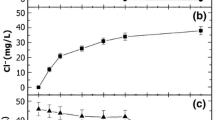Abstract
Chlorinated hydrocarbons such as trichloroethene (TCE) and tetrachloroethene are widely used as solvents and degreasing agents. Emission of these volatile compounds causes considerable environmental pollution. In the extreme case of spillage by accident or criminal negligence, they quickly penetrate into the soil and the groundwater table on account of their relatively high specific weight compared to water and their fluidity. In the soil under anaerobic conditions, these compounds undergo bacterial degradation, prominent products being cis-1,2-dichloroethene and vinyl chloride whose carcinogenic potential is known (Nerger and Mergler-Völkl, 1988).
Access this chapter
Tax calculation will be finalised at checkout
Purchases are for personal use only
Preview
Unable to display preview. Download preview PDF.
Similar content being viewed by others
References
Blystone, P. G., Johnson, M. D., and Haag, W. R. (1992), “Destruction of organic contaminants in air using advanced UV flashlamps”, Air & Waste Management Association 85th Annual Meeting, June 21–26, 1992, Kansas City, Missouri, paper No. 92–36.01.
Diller, W. and Schneider, W., “Phosgene”, in Ullmann’s Encyclopedia of Industrial Chemistry 5th Edition Volume A 19, Ed. by B. Elvers, S. Hawkins and G. Schulze, Verlag Chemie 1991.
Diller, W. and Zante, R., (1982), Zentralbl. Arbeitsmed. Arbeitsschutz Prophyl Ergon. 32, 60–368.
Eliasson, B. and Kogelschatz, U. (1988), “UV Excimer Radiation from Dielectric Barrier Discharges”, Applied Physics B46, 299 – 303.
Földiak, G. (Ed.) (1981), Radiation Chemistry of Hydrocarbons, Akademiai Kiado, Budapest, p. 69.
Glaze, W. H. and Kang, J. W. (1988), “Advanced Oxidation Processes for Treating Ground Water Contaminated With TCE and PCE: Laboratory Studies”, Research and Technology Journal AWWA, May 1988, 57 – 63.
Kogelschatz, U. (1992), “UV Production in Dielectric-Barrier Discharges for Pollution Control”, NATO Advanced Research Workshop on Non-Thermal Plasma Techniques for Pollution Control, Cambridge University, United Kingdom.
McGregor, F. R., Piscaer, P. J., and Aieta, E. M. (1988), “Economics of Treating Waste Gases From an Air Stripping Tower Using Photochemically Generated Ozone”, Ozone Science & Engineering 10, 339 – 352.
Mehnert, R., Klenert, P., and Hartmann, E. (1992), “LEA electron accelerators for radiation processing”, Nuclear Instr. Methods Physics Res. B68, 73 – 78.
Mertens, R. and von Sonntag, C. (1992); unpublished results.
Nerger, M. and Mergler-Völkl, R. (1988), “Biologischer Abbau von leichtflüchtigen Chlorkohlenwasserstoffen in Grund-und Abwasser”, Z. Wasser-Abwasser-Forsch. 21, 16 – 19.
Perkampus, H. H. (1971), UV Atlas organischer Verbindungen, Ed. Institut für Spektrochemie Dortmund, Verlag Chemie Weinheim.
Peyton, G. R. and Glaze, W. H. (1988), “Destruction of Pollutants in Water with Ozone in Combination with Ultraviolet Radiation”, Envir. Sci. Technol. 22, 761 – 767.
Sanhueza, E., Hisatsune, I. C., and Heicklen, J. (1976), “Oxidation of haloethylenes”, Chemical Reviews 76, 801 – 826.
von Sonntag, C., Mark, G., Mertens, R., Schuchmann, M.N., and Schuchmann, H.-P. (1993), “Chemical principles behind the use of UV-radiation and “active oxygen” (ozone, hydrogen peroxide) in water pollution control”, J. Water SRT-Aqua, in press.
von Sonntag, C. and Schuchmann, H.-P. (1992), “UV disinfection of drinking water and by-product formation — some basic considerations”, J. Water SRT-Aqua 41, 67 – 74.
Author information
Authors and Affiliations
Editor information
Editors and Affiliations
Rights and permissions
Copyright information
© 1993 Springer-Verlag Berlin Heidelberg
About this paper
Cite this paper
Scheytt, H., Esrom, H., Prager, L., Mehnert, R., von Sonntag, C. (1993). Ultraviolet Light and Electron Beam Induced Degradation of Trichloroethene. In: Penetrante, B.M., Schultheis, S.E. (eds) Non-Thermal Plasma Techniques for Pollution Control. NATO ASI Series, vol 34. Springer, Berlin, Heidelberg. https://doi.org/10.1007/978-3-642-78476-7_9
Download citation
DOI: https://doi.org/10.1007/978-3-642-78476-7_9
Publisher Name: Springer, Berlin, Heidelberg
Print ISBN: 978-3-642-78478-1
Online ISBN: 978-3-642-78476-7
eBook Packages: Springer Book Archive




